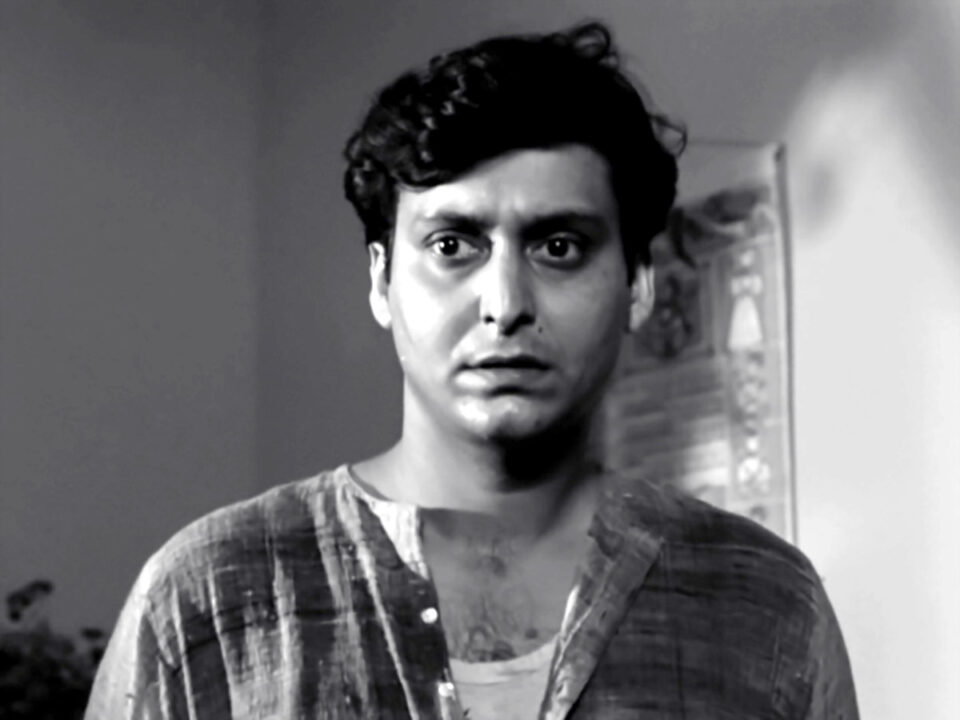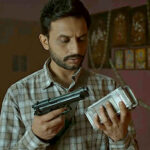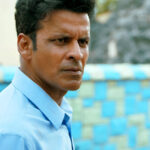This is an alternate list of 10 screen roles that saw Soumitra Chatterjee, a paragon of gentility, venture beyond his comfort zone and deliver masterclasses of subtlety and depth, lists Saibal Chatterjee.
Screen actor.
Theatre doyen.
Dramatist.
Poet.
Literary editor.
Soumitra Chatterjee, best known the world over as Satyajit Ray’s alter ego, was all that and more.
His international fame — in India, unfortunately, he wasn’t a household name outside Bengal — rests on the films he did with Ray. Hence the misconception that he did little else.
Chatterjee, who died in a Kolkata hospital on Sunday at 85, was a cultural icon who left an imprint across multiple domains.
The screen guises he donned, be it for Ray or other directors, projected a modern man vacillating between personal urges and social constraints.
His interpretations were universal, a fact that isn’t often recognised.
He played men who came from a specific linguistic milieu, but he was, especially in Ray’s masterpieces, the quintessential Indian growing up in a newly-free nation and struggling to achieve true liberation of the mind and the spirit.
Chatterjee was born in Calcutta but spent his formative years in the small town of Krishnnagar.
His was an artistically inclined family.
His grandfather and father were both active in local theatre but strictly as amateurs.
When Chatterjee moved back to Calcutta for higher education, he was drawn to professional theatre, where he learnt under the tutelage of the legendary Sisir Bhaduri and Ahindra Choudhury.
A common friend recommended him to Ray when the director was casting for the second film of the Apu Trilogy, Aparajito (The Unvanquished).
But he was too old to play the teenaged protagonist.
So, Ray waited until Apur Sansar (1959) to rope Chatterjee into his world.
It was the beginning of a collaboration on par with the ones that Ingmar Bergman had with Max von Sydow, Frederico Fellini with Marcelo Mastroianni, Werner Herzog with Klaus Kinski and Akira Kurosawa with Toshiro Mifune.
What are the titles that come instantly to mind when one dwells on Chatterjee’s 14-film association with Ray?
Apur Sansar, the actor’s screen debut, Charulata, the film that Ray regarded as his personal favourite, and the always fascinating Aranyer Din Ratri would figure prominently on most lists.
Deservedly so.
This, however, is an alternate list of 10 screen roles that saw Soumitra Chatterjee, a paragon of gentility, venture beyond his comfort zone and deliver masterclasses of subtlety and depth.
Punascha (Over Again, 1961)
In 1965, in Mrinal Sen’s Akash Kusum (Up in the Clouds), Chatterjee played a young man desperate to get ahead in life.
That is the film that always springs to mind when Sen is mentioned in the context of Chatterjee’s career.
But no less impactful was his performance in Punascha (Over Again), a marital drama the director made four years earlier.
It explored the changing face of the man-woman relationship in the context of the growing pressures exerted on the established patriarchal order as urban women left the domestic space and joined the workforce.
Chatterjee was unwaveringly pitch perfect.
Abhijan (The Expedition, 1962)
This was a leap of faith (for both the director and the lead actor) that came off famously.
In Abhijan, Satyajit Ray cast the urbane Chatterjee as Narsingh, a gruff, bearded Rajput taxi driver who gets involved with drug smuggling after losing his driving licence.
Waheeda Rehman (in her sole Ray film) played prostitute Gulabi, the hero’s love interest.
It wasn’t a film that Ray initiated.
He took over after the original director bailed out.
But both Ray and Chatterjee stamped their class on Abhijan, the latter by altering his demeanour completely and mixing his Bengali with Hindi words.
It was an amazingly convincing performance from the Apur Sansar and Devi actor.
Kapurush (The Coward, 1965)
In Satyajit Ray’s Kapurush, which usually plays with Mahapurush 1964, Chatterjee embodied a flawed man who thinks he can make it up to the woman he once betrayed.
The actor was class personified as a screenwriter whose car breaks down.
A tea magnate gives him shelter.
He realises that the latter’s wife is his former lover.
In a hurriedly written note, he suggests to the woman that she was welcome back into his life if she wished to leave her husband.
She turns down the offer.
Aparichita (The Stranger, 1969)
In this Salil Dutta film, one of the handful in which Chatterjee and mahanayak Uttam Kumar appeared together, the former delivered a stunning performance as a man recovering from a mental breakdown.
The film itself was a melodrama that banked on heightened emotions, but Chatterjee, playing a naive young man to Uttam Kumar’s aggressive gangster and Aparna Sen’s woman forced into prostitution by her politician employer, held the film together with a performance of a lifetime.
Aparichita does not usually pop up on Soumitra Chatterjee hit parades, but deserves to.
Ashani Sanket (Distant Thunder 1973)
Coming a decade and a bit after Abhijan, Ashani Sanket, Ray’s Berlin Film Festival Golden Bear winner, had Chatterjee cast against type once again.
The actor mastered the body language of a Brahmin priest in a famine-hit Bengal village of the early 1940s with an unfailing eye for detail.
It is known that Chatterjee invested a great deal of time and effort to get it right, accompanying the director on recce to grasp the nuances of rural life.
The result was a performance of exceptional quality.
Sansar Simantey (The Edge of the World, 1975)
Another acclaimed film in which Chatterjee brought alive a fictional character far removed from his own background, Tarun Majumdar’s Sansar Simantey had the actor playing a thief sheltered by a prostitute in Calcutta.
The two subalterns exist on the fringes of society and their love, too, borders on the impossible.
They constantly find themselves in choppy waters not just with the world around them, but also in relation to each other.
Another stunning feather in the cap for the actor.
Kony (1984)
Outside the Ray-Sen-Tapan Sinha-Tarun Majumdar universe, Kony, a sports film about a temperamental, greying but fit as a fiddle swimming coach and the titular street girl he takes under his wing, is probably Chatterjee’s best-known film.
The myriad-faceted persona that the lead actor fleshed out was relatable all the way.
As a result of his restrained performance, Kony, adapted by writer-director Saroj De from a story by sports journalist and novelist Moti Nandy, managed to keep overt sentimentalism in check.
Ganashatru (An Enemy of the People, 1989)
The first of the three final films that Ray made about contemporary Calcutta after he suffered a heart attack and was constrained to work within the physical and technical limitations his frail condition imposed upon him, Ganashatru, in a way, brought Chatterjee closer than he had ever been to articulating the film-maker’s worldview on the screen (almost in the manner that Utpal Dutt did in Ray’s final film, Agantuk).
He was terrific as a doctor who calls out a temple whose ‘holy’ water causes a jaundice epidemic.
Ganashatru transposed Norwegian playwright Henrik Ibsen’s An Enemy of the People to a Bengal setting.
Chatterjee, with his active theatre background, was the perfect choice to play the lead.
Wheel Chair (1994)
In Tapan Sinha’s Wheel Chair, Chatterjee was a paraplegic doctor who runs a clinic where a survivor of a sexual assault is wheeled in.
The woman is paralysed from the neck down.
The doctor and his young assistant help her cure herself physically and emotionally.
Chatterjee’s interpretation of the character, aided by emphasis of the writing, never allows the interventions to suggest a selfless saviour syndrome.
The woman wasn’t without agency.
One of the finest of the actor’s long and glittering career.
Dekha (Perceptions, 2001)
One of Director Goutam Ghose’s most accomplished films derived much of its strength primarily from a phenomenal central performance by Chatterjee.
The actor played a one-time Bohemian poet, now blind and struggling to shrug off the burden of memories and to reckon with the inability to find renewed inspiration.
Rarely has the state of being visually impaired been enacted with as much finesse — and empathy — in an Indian film.
Indeed, what Chatterjee delivered in Dekha was a performance of blinding brilliance, measured to perfection.
SPECIAL MENTIONS
Mayurakshi (2017)
Atanu Ghosh’s sensitive drama had Chatterjee in the role of an 84-year-old retired history professor dealing with dementia as his son, in the throes of a personal crisis of his own, flies down from Chicago to tend to his ailing father.
Basu Poribar (2019)
In Suman’s Ghosh’s family saga, which reunited Chatterjee with his most frequent female co-actor Aparna Sen, was a patriarch celebrating his 50th wedding anniversary when a family reunion is unsettled by long suppressed secrets.
Borunbabur Bondhu (2019)
In this critically lauded film, Director Anik Dutta cast Chatterjee as an aloof and abrasive octogenarian who has shut the world except to an old friend. It brought together the thespian and his Charulata co-star Madhabi Mukherjee, who played his bedridden wife.
Feature Presentation: Rajesh Alva/KhabriBaba.com




